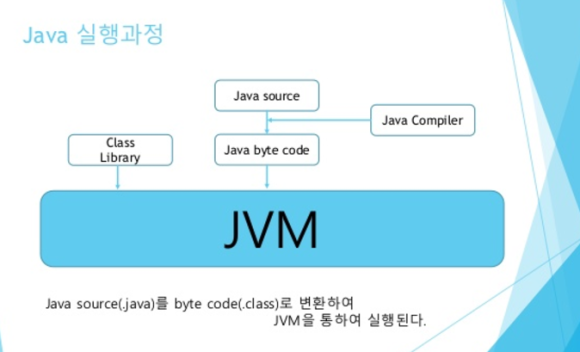JVM(JavaVirtualMachine)이란
- Java의 중간 코드를 실행할 수 있는 주체
- Java와 OS사이의 중개자 역할
- Java가 OS에 종속되지 않고 사용가능하게 해줌.
- 메모리 관리 기능(용도에 따라 여러 영역으로 나누어 관리), Garbage Collection을 제공
Java 프로그램과 일반 프로그램의 실행구조는 아래와 같다.
왼쪽이 Java , 오른쪽이 그외 JVM을 사용하지 않는 언어들로 작성한 프로그램의 실행 구조이다. 앞서 설명한 바와 같이 Java의 경우는 JVM이 OS로 부터 메모리 사용권한을 받아 프로그램을 실행시켜주기 때문에 JVM이 지원하는 모든 OS들에 독립적일 수 있다.
아래의 Java의 실행과정을 보면
사용자가 Java로 작성한 코드(.java)는 컴파일러를 거쳐서 중간코드인 Java Byte Code(.class)로 나오고 이를 JVM에서 실행하는것을 확인할 수 있다.
JVM의 구성
- Class Loader= 모든 클래스는 참조되는 순간에 동적으로 JVM에 Link되며 메모리에 로딩되는데, 동적 클래스 로딩은 Class Loader을 통해서 이루어 진다.
JVM은 클래스에 대한 정보를 알지 못하기때문에 main이 실행되기 전에 Class Loader가 클래스를 로딩할 때 필요한 정보를 구하고, 클래스가 올바른지 검사한다.
- Execution Engine= Class Load 작업 후 , Byte Code는 Runtime Data Area에 배치된다. JVM은 Method(=Class) Area의 Byte Code를 Execution Engine에 제공하여 Class에 정의된 내용대로 실행하게 된다.
즉 Execution Engine이란 ByteCode를 실행하는 Runtime Module이다.
※ Runtime Module의 방식은 Interpreter랑 JIT(just in time) Compiler 방식이 있다.
- Runtime Data Areas = 프로그램을 수행하기 위해 OS에서 할당 받은 메모리 공간
1. Class(=Static=Method) 영역
사용하는 클래스 파일의 바이트 코드가 로드되는 곳으로 static 변수의 값 그리고 멤버 변수, 메소드 등 클래스에 대한 정보=metadata(값아님)가 JVM이 종료될때 까지 유지된다.
이렇게 Class 영역에 바이트 코드가 올라가는 것을 ClassLoding 이라고 하며 ClassLoding 이 되야 하는 이유는 메소드를 호출하기 위해서는 먼저 그 메소드를 갖고 있는 클래스 파일(바이트 코드)이 메모리에 로딩되어 있어야 하기 때문이다.
2. Stack 영역
지역변수와 매개변수가 저장되는 곳으로 메소드가 호출되거나 로프문안으로 들어왔을때 스택영역에 메모리를 할당한다. 지역문 안에서만 임시 할당 되있다가 지역문이 끝나면 삭제된다.
3. Heap 영역
기본형 변수를 제외한 참조형 변수들이 가르키는 곳(주소)에 내용이 저장되는 영역이다. 흔히 new를 통해 생성된 인스턴스가 저장되는 곳이다.
예를 들어 아래와 같은 A라는 클래스가 있다고 가정했을때
이렇게 메인 메소드에서 sample 인스턴스를 생성하게 되면
Stack영역에는 지역변수인 sample과 sample의 내용이 저장된 주소값이 저장되고
Heap영역에는 sample 안에 있는 인스턴스 변수인 int a와 String str이 저장되게 된다.
즉 new 로 생성된 객체의 내용은 Heap영역에 저장되고 참조형 변수인 sample은 main함수 안에 있는 지역변수 이므로 Stack영역에 저장되는 것이다.
※힙 영역에 저장된 내용들은 참조형 변수가 참조하지 않게 되어 가비지가 되면 가비지 컬렉터에 의해 제거되거나 JVM이 종료되면 제거된다.
- GC(Garbage Collector)
참조되지 않은 객체들을 탐색 후 삭제 후 , 삭제된 객체의 메모리를 반환한다.
※ stop-the-world = GC을 실행하기 위해 JVM이 어플리케이션 실행을 멈추는 것으로 GC를 실행하는 Thread를 제외한 나머지 Thread는 모두 작업을 멈춘다. (stop-the-world를 줄이기 위한것이 GC 튜닝)
'프로그래밍 > OS' 카테고리의 다른 글
| 리눅스 which ,where ,locate (0) | 2018.07.21 |
|---|---|
| 리눅스 touch - 파일생성 및 파일의 날짜정보 변경 (0) | 2018.07.21 |
| JVM이란? (0) | 2018.04.21 |
| JVM 메모리 구조에서 method 의 저장위치 의 애매한 개념에 대한 정확한 답변 (0) | 2018.04.21 |
| Process 와 Thread 의 차이 (0) | 2018.04.16 |








